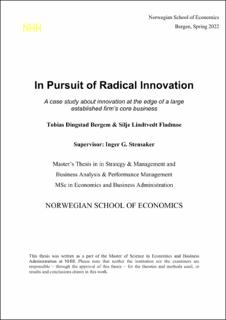In Pursuit of Radical Innovation: A case study about innovation at the edge of large established firm’s core business
Master thesis
Permanent lenke
https://hdl.handle.net/11250/3013143Utgivelsesdato
2022Metadata
Vis full innførselSamlinger
- Master Thesis [4372]
Sammendrag
The purpose of this master’s thesis is to examine how large established firms can radically
innovate at the edge of their core business and how edge initiatives can develop over time.
Since there is limited research on the topic, we explore this phenomenon through an
exploratory case study of a large established firm and its edge initiative in the context of the
mobility industry in Norway. Through in-depth interviews, we find and present key features
of an edge solution and show how it can develop over time.
The first key feature of the case company’s edge solution is providing the edge autonomy by
keeping it at arm’s length from the established business. We show and argue how to achieve
arm’s length and how it can facilitate the development of external relations, increased
competitiveness, and stand-alone value. The study further points to management sponsors’
importance in reducing core resistance and shielding the edge from its negative
consequences. It also illustrates the need for upwards managing in the edge’s early phases.
However, our findings highlight how the role turns towards time relief as the edge gains a
more solid standing in the established firm. The last feature of the solution presented in this
thesis relates to how gradual funding reduces the risk for the core and how giving the edge
entrepreneurs co-ownership can create a passionate team. We argue that these features
collectively allow the edge to innovate and grow.
Finally, a vital contribution of this thesis is the insight into the development of the edge
initiative. Our findings suggest that the intent with an edge might change as it evolves and
grows. We discuss when and whether to integrate, spin-off, or continue to innovate at the
edge and suggest that future research explore potential trajectories further.
